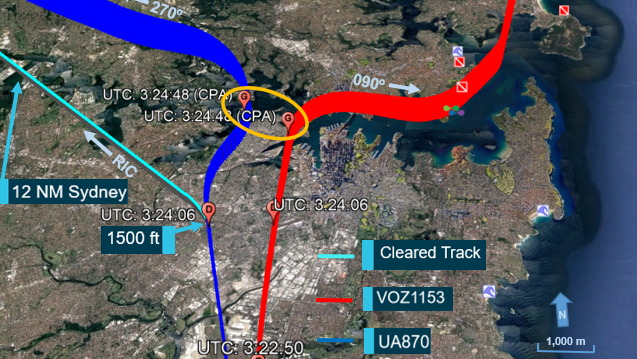
|
Key points:
|
Likely flight crew confusion with Sydney-centric departure procedures contributed to a Boeing 777 turning right instead of left on departure from Sydney Airport, resulting in a loss of separation with an ATR72 which had taken off from the parallel runway, an ATSB investigation notes.
The United Airlines Boeing 777-300ER had departed from Sydney Airport’s runway 34 Left bound for San Francisco and was cleared to follow a standard instrument departure (SID) requiring the aircraft to maintain runway heading until reaching 1,500 feet, at which point the aircraft was required to turn left and track towards Richmond, northwest of Sydney. However, the 777 instead climbed straight ahead through 1,500 feet to about 2,100 feet and then turned to the right, resulting in a loss of separation with the Virgin Australia ATR aircraft, which had departed from the parallel runway (runway 34 Right).
“The Sydney air traffic control departures controller detected that the 777 was turning right and instructed the crew to immediately turn left,” noted ATSB Director Transport Safety Dr Stuart Godley.
“The departures controller then issued a separate instruction to the ATR 72 to turn right. At their closest point of approach, the two aircraft were separated by about one nautical mile laterally and about 200 feet vertically.”
Dr Godley noted that while the ATSB categorised this particular loss of separation as a serious incident, both aircraft were fitted with advanced traffic alert and collision avoidance systems (TCAS), which would have alerted the flight crews of each aircraft of any likely flight path conflicts, had the departures controller not issued interventional instructions.
The ATSB’s investigation found that in entering the cleared ‘RIC5’ standard instrument departure in the 777’s flight management computer (FMC), the aircraft captain, who was the pilot flying, closed (removed) a deliberate ‘discontinuity’ – or gap – in the waypoint sequence. This discontinuity was pre-programmed to represent where air traffic control was to provide radar vectors to transition from the SID to join the planned oceanic track to San Francisco.
In removing the discontinuity, likely due to the captain’s limited exposure to the assignment of varying Sydney-centric departure procedures, the aircraft was in effect programmed to track direct to a navigation waypoint (DIPSO), about 45 nautical miles to the east of Sydney, after reaching the initial waypoint at 1,500 feet. This resulted in the right turn and the subsequent loss of separation with the ATR72.
Removing the discontinuity would have been appropriate for many procedural transitions, which are commonplace in the United States, Dr Godley noted.
“This reprogramming may have been due to an unfamiliarity with radar transitions from a standard instrument departure to an en route track.”
The ATSB’s investigation also notes that the pilot flying probably did not effectively communicate the changes made to the FMC coding to the other members of the flight crew, after reprogramming the FMC from the anticipated simpler ‘SYD1’ standard instrument departure, which had been entered based on previous experience.
“This occurrence illustrates the importance of procedural correctness, effective communication and crew coordination,” said Dr Godley.
“Any amendment to the flight management computer, particularly those applicable to the more critical phases of flight such as departure and arrival procedures, should always be announced, and then carefully and independently verified by at least one other crew member.”
The incident also highlights that, when possible, air traffic controllers can potentially further assist foreign flight crews when providing airways clearances by proactively factoring the crew’s possible unfamiliarity with local procedures.
Read the report: Loss of separation involving Boeing 777, N2333U and ATR 72, VH-FVQ, near Sydney Airport, New South Wales, on 22 January 2020


